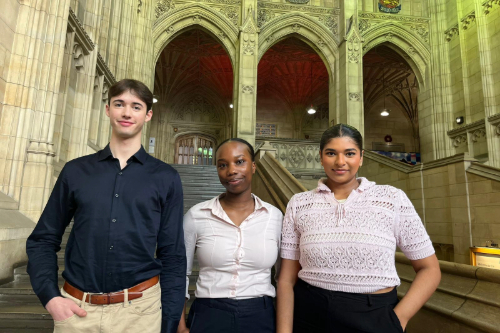Students Address Disparity in Black and Brown Skin Cancer Diagnosis
Three medical students are solving the shocking disparity in skin cancer care between those with dark skin and those with white skin.
Stunned to learn that UK doctors were far more likely to misdiagnoses skin cancers in those with black or brown skin, University of Bristol medical students Mariana Wickramarachchi, Harvey Hill and Elizabeth Maregere decided to act.
Their start-up DermSpectrum is building the UK’s most diverse and advanced skin image bank, to teach students and clinicians how to diagnose skin conditions regardless of colour.
In the US, 5-year skin cancer survival rates are 70% for black people and 92% for white people. In the UK, equivalent studies are not widely available – but a study of GPs found they were much more likely to misdiagnose melanomas in dark skin.
The students hope that improving early diagnosis of skin cancer in black and brown people will save lives, improve equality and lighten the load on the NHS.
The answer: upskilling students
Upskilling students before they qualify is key. After surveying students at UK medical schools, they found trainee doctors were nearly twice as confident at diagnosing conditions on white skin compared to skin of colour.
Harvey said: “It’s shocking seeing the underrepresentation in the UK curriculum. We went through one of the most widely used medical textbooks in the UK, with 1.5million copies sold. Out of the 600 diagrams and images of patients, we could only find fewer than 10 images of patients with black or brown skin.
“Medical students are the starting point. We want this to be a resource for students and then we want to roll it out to the rest of the medical community from there.”
The cost of late diagnosis
Improving diagnosis is not just a moral action but also financial. Healthcare costs for those diagnosed with Stage IV melanoma are reported to be between 25 and 52 times higher than for those diagnosed at Stage IA.
The cost of diagnosing and treating skin cancer in the UK is estimated to rise to between £338 and £465 million a year by 2025.
Elizabeth said: “Misdiagnosis or missed diagnosis, due to inadequate representation, can have massive repercussions on patients. We want to increase diversity within medical education to reduce inequality, for black and brown people.”
Mariana said that current skin banks included mostly photos of white skin and that they often used an “outdated and subjective” classification system.
DermSpectrum’s online resource will allow users to explore skin conditions using an intuitive image filtration system, including a slider to choose skin tone, and options to filter by location on the body and appearance of the skin condition. The founders of DermSpectrum are also exploring how artificial intelligence can be used to aid the diversity of dermatology image banks.
Funding success
DermSpectrum came from the Learn2Innovate programme, which equips students with tools to innovate the medical field. DermSpectrum was awarded first place, securing £1,000, and beating 40 other students from four universities.
DermSpectrum has also won £3,500 from the University of Bristol’s Jim and Peggy Wilkinson Innovation Fund to develop the start-up. They are using the funds to build the image bank and launch their website.
The start-up was recently accepted onto Samsung Solve for Tomorrow, a competition that includes workshops, mentoring and a chance to win £10,000.
‘Transform medical education’
Prof Chrissie Thirlwell, Head of the University of Bristol Medical School, said: “I’m incredibly proud of our students’ innovation, entrepreneurship and drive to address this and other health inequalities both in clinical scenarios and across medical education.
“Bristol Medical School is very grateful to the Jim and Peggy Wilkinson innovation Fund which has generously supported Mariana, Harvey and Elizabeth to further develop and launch DermSpectrum.”
Ropsana Khanom, a fourth-year medical student and Equalities Director of Galenicals (Bristol Medical Students’ Society), said: “The work of our fellow students with DermSpectrum inspires us all here at Bristol Medical School.
“As future doctors hoping to transform medical education, start-ups like this will contribute to addressing health inequalities in dermatology.”

